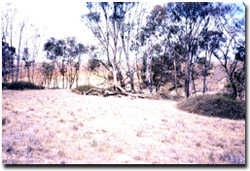Site 2 Reseigh’s
This site appears to be in environmental decline
Description
The area is freehold, fenced from grazing and listed as Land for Wildlife. The site is adjacent to the Richardson River on a narrow alluvial plain at an altitude of 120 m.
The area has moderate habitat value due to the high value of the riparian vegetation being reduced by high salinity levels of the Richardson River.
| Vegetation Description and Composition This freehold area comprises areas of Grassland and Open Woodland dominated by Eucalyptus largiflorens (Black Box) and Eucalyptus camaldulensis (Red Gum). Native grasses, members of the Asteraceae and Chenopodiaceae (saltbush) Families, dominate the Grassland section. The understorey of the Open Woodland adjacent to the Richardson River is predominantly Muehlenbeckia florulenta (Tangled Lignum) and Eragrostis infecunda (Cane Grass). The EVC mosaics represented are Riverine Grassy Chenopod Woodland and Plains Woodland. The 1997 survey indicated that about 30% of the species present were introduced mostly from the Asteraceae and Poaceae (grass) Families. The number of total plant species present has dropped between 10% to 20% in 2002. The decreases were mainly from introduced species from the Asteraceae Family. The species present now are changing to more drought tolerant species. |  The Richardson River runs directly behind the stand of trees |
The “vrot” Muehlenbeckia horrida (Spiny Lignum) was still present.
Tree Health
Eight trees are monitored for tree canopy health using a 20-point system assessing canopy size and density, number of dead branches and extent of epicormic growth. Leaf damage by insects is also assessed. Four trees, all Red Gum have experienced severe decline in health since 1997 due to reduced canopy density, dead branches and epicormic growth. These are signs of stress due to prolonged dry conditions. Eucalyptus camaldulensis (Red Gum) trees appear to be suffering greater amounts of insect attack and epicormic growth than the Eucalyptus largiflorens (Black Box) trees, because they cannot withstand long periods without inundation. Highly saline groundwater is also contributing to decline in vegetation health at this site (refer to groundwater and salinity section).
Groundwater and Salinity
Two long term monitored bores are located adjacent to the site and were approximately 4m below natural surface in 2002. They respond to seasonal fluctuations and have dropped in response to dry conditions. They are also demonstrating a high rising pressure trend above the water table, which means that the deep drainage capacity around the site is limited (similar to the situation found at Lake Buloke). Salinity levels of the groundwater are extremely high (>30 000 EC in 2002) and is of concern if the groundwater level was to rise further. Saline groundwater intrusion into the Richardson River is having downstream effects when it flows from the site of intrusion to Lake Buloke. The Richardson River (300 m away from the site) is currently dry at present but when it contained water in November 1999, an EC reading recorded 52 000 EC. Due to the combination of factors listed above, if salinity mitigation works do not have an effect on this site in the near future, the ecological health of the vegetation is in jeopardy.
Birds
Bird species present at the time of the vegetation and tree health surveys were :-
Galah Magpie, Red-rumped Parrot, Welcome Swallow, White-plumed Honeyeater, Willie Wagtail, Eastern Rosella and Brown Tree Creeper.
Threats to the site continue to be:
- possible future grazing and weed invasion
- Increasing salinity levels in the Richardson River from groundwater intrusion.
- Rising water tables affecting the vegetation and ecological health of the site


